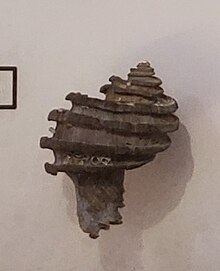|
Ecphora (genus)
Ecphora is a genus of extinct predatory ocenebrinid murexes indigenous to the North American Eastern Seaboard from Miocene until their extinction during the Pliocene. The common name for this genus and a group of related genera is "ecphora"(s). EtymologyThe name "Ecphora" is Greek, meaning "bearing out." The word was originally used by Vitruvius to signify the projecture of a member or moulding of a column, and here refers to the distinctive "T-shaped" ribs that project from the shell.[2] SubdivisionsAs originally proposed by Petuch in 1988, Trisecphora was regarded as a subgenus of Ecphora (sensu stricto), as was the genus Latecphora. However, further study (by Petuch) of these two subgenera lead to their promotion to genera proper. However, Planecphora Petuch 2004 was originally proposed as a full genus, but was then demoted to subgenus. Currently, Ecphora is subdivided into the subgenus Planecphora, and several species complexes. Originally, the species of Planecphora consisted of the "Ecphora choptankensis Species Complex" before Petuch elevated the complex to genus status. Subgenus Planecphora
Ecphora (sensu stricto) Ecphora gardnerae Species Complex
Ecphora meganae Species Complex
Ecphora rikeri Species Complex
Ecphora quadricostata Species Complex
EvolutionEcphora is derived from the slightly older Trisecphora, diverging during the Langhian epoch. The oldest species is E. wardi, found in the Plum Point Member of the Calvert Formation. Later during the Miocene, daughter genera, in the form of Latecphora, and Globecphora, and Planecphora split off during the early Pliocene, persisting in a coral atoll in what is now the Everglades until the late Piacenzian epoch of the late Pliocene, when remaining species of both Ecphora and Planecphora were driven to extinction due to encroachment by new murexes invading from the south. References
External links
|
||||||||||||||||||||||||||
